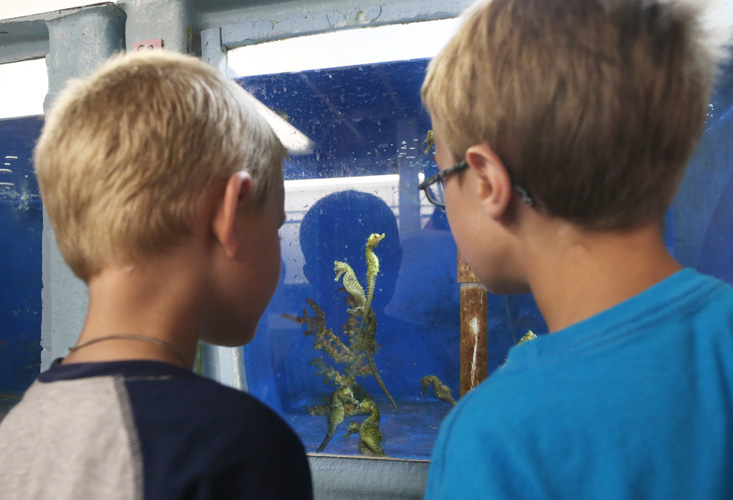
When we think of charismatic species in the lagoon, bottlenose dolphins and manatees leap to mind first, but there is another very charming species in the estuary that many people don’t even know about: Seahorses.
Nancy Pham, manager of Florida Institute of Technology’s Vero Beach Marine Laboratory, is the island’s resident expert on the storybook creatures.
“People love seahorses,” says Pham, who became lab manager in 2012 after graduating from FIT with a master’s degree in Marine Biology. “They are like a box full of kittens!”
So far in her seahorse research, Pham has discovered the popular aquarium creatures, which are monogamous in the wild, are promiscuous in captivity where there are greater opportunities for multiple mates. She is also trying to unravel the mystery of why male seahorses, not female, are the ones that get pregnant and bear young.
In late 2013 she added a genetic diversity study to her workload.
Working with citizen scientist volunteers at lagoon education and research organizations, Pham is gathering genetic samples along the length of the 156-mile waterway to figure out the origins of local seahorses, the diversity of the population and how well the delicate animals are doing in the lagoon’s troubled waters.
When a volunteer finds a seahorse, “they can give me a call and I go out and show them how to obtain a DNA sample and then release the animal back into the wild,” Pham says.
Using tweezers and cuticle scissors, a tiny clip is taken from the soft tissue of the animal’s dorsal fin and put into a vial of alcohol for genetic testing back at the lab.
To make the project more fun, Pham names each seahorse that yields a sample and keeps the volunteer that provided the sample informed of its genetic results and the overall progress of the research.
“I call it my ‘adopt-a-seahorse’ program,” she says. “The volunteers actually get to pick the names and then find out where the seahorse’s ancestors came from.”
A main goal of the research is to gauge the survivability of the lagoon’s seahorse population. The more genetically diverse the animals are, the more likely some will survive ecological trauma such as increased water pollution or a sudden cold snap. If they are all the same, a single stressor is more likely to kill all or most of them.
Drawing on seahorse charisma and the public’s general fascination with marine biology, Pham has had success attracting the public to FIT’s Marine Lab in Indian River Shores adjacent to Tracking Station Park.
She has 17 student interns who work alongside scientists at the lab taking care of animals and assisting with research and in 2013 she launched a summer camp for 10- to 12-year-old children.
“Last year we started with 10 students. This year we were able to expand to 13 students and did it for two weeks, so we had a total of 26 students.”
Children learn about marine biology, use of scientific instruments, aquaculture, aquarium care and local conservation research projects.
This year, each student was assigned an aquarium in which they raised clownfish, feeding some fish one diet and others an alternate diet as a scientific experiment.
“They learned about the scientific method and the importance of replication and how to control variables and little bit about statistics,” Pham says. “They basically did my master’s thesis in a week!”
They also got to eat some seafood samples.
“We incorporated a ‘farm to fork’ aspect this year,” Pham says. “They ate lionfish and compared the taste of wild and farm-raised shrimp.”
FIT last year announced plans to significantly expand the Vero lab and add more public facilities. University spokesman Wes Sumner says that effort is ongoing as part of a $100 million capital campaign.
University President Anthony James Catanese said last year the new lab can be customized to accommodate research and education programs donors want to see.



